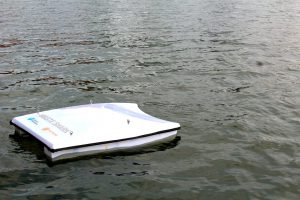
The Netherland’s second largest city recently hired RanMarine Technology to deploy its latest innovation – the Waste Shark – a drone that can chow down up to 1,100 pounds of trash.
Company CEO Richard Hardiman says the six-month contract with the Port Authority of Rotterdam is only the first step in a quest to clean up the world’s waterways.
“It may sound like a strange thing to say for an entrepreneur, but my mission will only truly be accomplished when I’m out of business,” Hardiman states in a press release, adding that he hopes the Waste Shark will eventually help “clean up the mass of ‘plastic soup’ suspended in the world’s oceans.”
Europe’s largest port and world’s sixth-largest port in terms of annual cargo tonnage, the port’s waterways accumulate tons of waste every year.
“Humans are very good at forgetting where waste truly ends up,” Hardiman said in a recent interview with Silicon Angle. “It if it’s not going into some landfill somewhere then odds are it has ended up in a storm-water drain, river or outlet and then off into the ocean never to be seen again; by humans that is. The impact of plastic soup and these huge plastic islands out in the Pacific ocean and elsewhere cannot be underestimated.”
The size of a passenger car, the Waste Shark scoops up waste with a mouth-like mechanism that stays submerged about 12 inches under water as the drone glides silently and autonomously on its predatory mission. The drone can be equipped with several different sensors to measure water quality, wind speed, weather condition and other data that can be wirelessly transmitted to its operators.
Deploying drones as trash haulers is not a new concept. In February, Swedish waste management company Renova teamed up with Volvo to launch a combined aerial and ground-based robotics system called the ROAR project (RObot-based Autonomous Refuse handling). The system uses a drone to survey an area when a truck pulls up at a full trash can. The drone identifies the trash can and maps out the route for the ground robot to find and empty trash can using LIDAR for navigation.
In Spain, Barcelona officials are exploring drone use in an equally stinky situation — inspecting the city’s sewers.
Jason is a longstanding contributor to DroneLife with an avid interest in all things tech. He focuses on anti-drone technologies and the public safety sector; police, fire, and search and rescue.
Beginning his career as a journalist in 1996, Jason has since written and edited thousands of engaging news articles, blog posts, press releases and online content.
Email Jason
TWITTER:@JasonPReagan
Subscribe to DroneLife here.